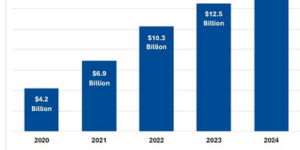 For all the talk of technology disrupting insurance, most of the innovations unveiled at the 2018 Global Insurance Symposium were focused on helping consumers, agents, brokers and carriers make better use of existing insurance products.
For all the talk of technology disrupting insurance, most of the innovations unveiled at the 2018 Global Insurance Symposium were focused on helping consumers, agents, brokers and carriers make better use of existing insurance products.
As in past symposia, this year’s event, held April 24-26 in Des Moines, featured presentations of technology initiatives supported by the Global Insurance Accelerator (GIA), a consortium of Iowa insurance organizations and government agencies.
Every year since its creation in 2014, GIA has provided seed money and mentorship to nascent technology firms for the development of insurance and risk management applications. In return, the GIA is granted a small equity position in the organizations it supports.
Among the GIA’s 2018 cohort of projects were four that addressed stages of the property/casualty underwriting process.
InsuredMine Has Agent Portal/Customer App With Promise
In commercial lines, many agents are ill-equipped to help clients select coverages and limits from the myriad options now available, said Raution Jaiswal, founder of InsuredMine, in his presentation to the symposium. As a result, “agents are not maximizing customer lifetime value” in commercial lines, he said.
Based in Dallas, InsuredMine has developed an agent portal and customer app designed to help parties visualize an entire insurance portfolio and its component parts. Insureds can readily see all of their policies, coverage limits, deductibles and other key variables, while agents can display comparisons among policy options, a valuable feature for clients seeking to optimize their premium dollars.
Jaiswal estimates that commercial accounts will, on average, purchase 25 percent more coverage (measured in premium) with a process such as that built into GIA.
Once an agent and commercial client know what coverage they want to purchase, it can be complex and time-consuming to find the right carrier to provide it, especially if it is a specialized type of coverage for hard-to-place risks.
ProtectRisk Promoted Its Specialty Program Database
That’s the problem addressed by ProtectRisk, of Washington, D.C. In his presentation at the symposium, Asseged Major, ProtectRisk’s principal, offered the observation that “specialty insurers’ products are creative, but their processes are out of date,” requiring much back-and-forth correspondence to select, quote and bind the desired coverage.
 To address this, ProtectRisk provides an extensive database with search capabilities of specialty program markets with indications of their risk appetites. “All in one place,” he said, “we can have the client or broker get a quote, bind coverage and collaborate easily with underwriters.”
To address this, ProtectRisk provides an extensive database with search capabilities of specialty program markets with indications of their risk appetites. “All in one place,” he said, “we can have the client or broker get a quote, bind coverage and collaborate easily with underwriters.”
Those underwriters, in turn, need to understand the risks they’re evaluating. Today, there is an unprecedented abundance of information for doing so, said Tom Smith, president of AuthorityData in Tempe, Ariz., another GIA-supported enterprise.
The exponential growth of the “Internet of Things,” to the point where the number of risk sensors deployed around the world exceeds the number of smartphones, constitutes the “largest growth of a technology in human history,” Smith told the symposium.
The problem is that the amount and variety of “IoT” data can be overwhelming and unmanageable for insurers, he said, and most carriers do not have the “core competency” to evaluate technology vendors for the quality and usefulness of their data.
AuthorityData Can Aggregate/Validate Data From IoT Devices
To that end, AuthorityData has developed a process for aggregating and validating data from IoT devices and for selecting data relevant to the perils covered under a property policy. From this, AuthorityData can generate risk profiles and risk scores for prospective insured locations.
The potential benefits of harnessing IoT data are enormous, said Smith, who claimed that 93 percent of indoor water claims, which amount to about $8 billion a year in insured losses, could be eliminated by utilizing sensors to detect leaks and other problems in water systems.
The work of underwriting doesn’t end once coverage is bound, said Michael DeSiato, founder of the Miami-based firm RiskPossible, which presented its new “Continuous Underwriting Engine (CUE)” at the symposium.
(Related Story : Underwriting in 2018: InsurTechs Eye Analytics, Automation)
DeSiato laid out the problem facing insurers in two anecdotes. In one case, a restaurant that was underwritten and insured as a casual dining establishment started operating as a dance hall. As a result of that activity, the restaurant incurred a $2 million fire loss.
In the other case, a liability claim, a contractor underwritten and insured for installing drywall acquired an electrical license during the policy period. In its new line of work, the contractor “fried” a home electrical system, DeSiato recounted, and its liability insurer had to respond to the claim.
How RiskPossible’s ‘Continuous Underwriting Engine’ Works
“Risks are not static; they can change during the policy term,” DSeSiato told the group. To help insurers stay abreast of their insured’s exposures, RiskPossible mines public and proprietary data sources—from newspaper announcements of events to the issuance of licenses, and more—to alert insurers to changes in their risks so they can initiate loss control or underwriting actions.
Other presentations at the GIS showcased innovations primarily devoted to life and health insurance. These included:
- Insurmi.com, Phoenix, Ariz., an online platform designed to provide a “conversational” approach to purchasing life insurance.
- LVLFi (pronounced “level-FI”), based in London, which provides a platform of online games designed to make it fun and provide incentives for individuals to pursue fitness goals.
- Byeo (pronounced “bye-o”), Chihuahua, Mexico, which developed a smartphone app designed to help life insurance policyholders manage end-of-life situations by creating secure repositories of documents and instructions.
- JAUNTIN‘, Toronto, Ont., developers of a platform designed to allow users to purchase short-term insurance policies for situations they occasionally encounter, such as the need for special health insurance or rental insurance when on vacation.
GIA-supported initiatives aren’t just pipe dreams, said Jeff Russell, CEO of Delta Dental of Iowa and GIA chairman, in his general introduction to the presentations. The projects listed above and from previous years “have real customers paying real money for real value,” he said.
“Innovation at its core is messy,” he added. “To really embrace innovation you have to budget for innovation, and it has to be okay to try and fail.”
“At the Global Insurance Accelerator, we think that the best way to predict the future is to create it.”





















 Severe Midwest Storms Result in Baseball Size Hail
Severe Midwest Storms Result in Baseball Size Hail  Roof Repair and Replacement Costs Up Nearly 30% Since 2022: Verisk
Roof Repair and Replacement Costs Up Nearly 30% Since 2022: Verisk  Federal Bill Reintroduced to Combat Organized Retail Theft
Federal Bill Reintroduced to Combat Organized Retail Theft  The Growth of a New Wave of Distribution Startups in Commercial Auto Insurance
The Growth of a New Wave of Distribution Startups in Commercial Auto Insurance 









